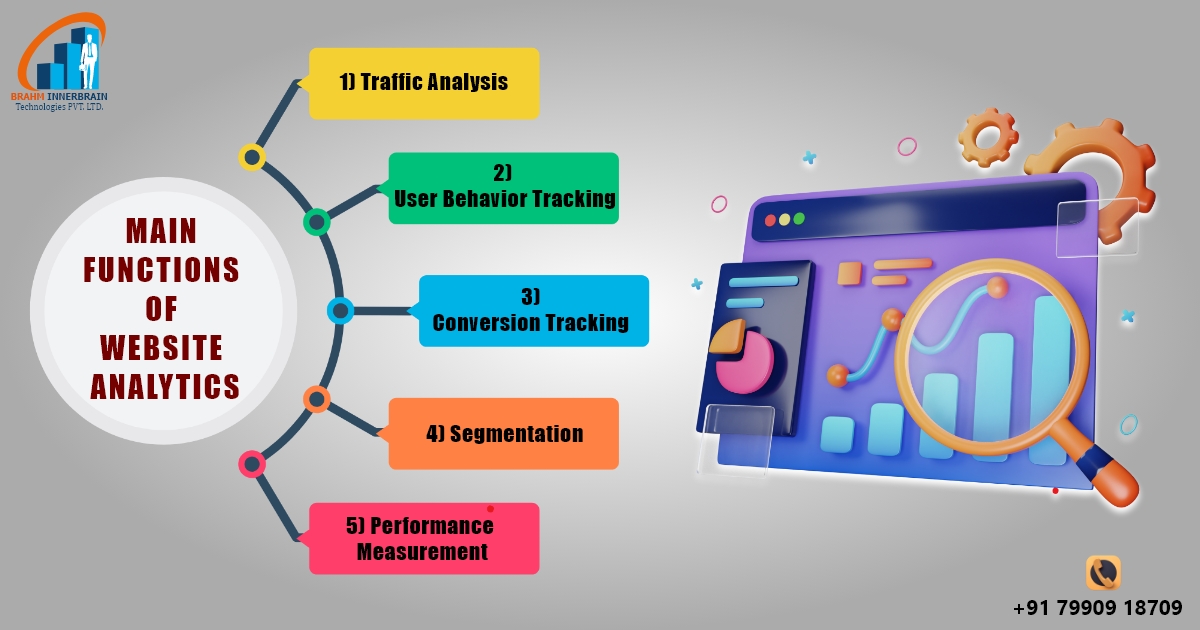
Website analytics refers to the systematic measurement and analysis of data related to web traffic and user behavior.Website Analytics provides businesses with the insights necessary to understand how people interact with their websites, allowing them to make informed decisions to enhance user experience, optimize marketing efforts, and drive business results.

Main Functions of Website Analytics:-
1) Traffic Analysis :
Website analytics begins with a fundamental examination of traffic analysis, which involves measuring the number of visitors to a website, understanding their geographic locations, and pinpointing the sources that bring them to the site. Utilizing website analytics tools like Google Analytics, businesses can determine the effectiveness of various marketing channels, such as organic search, paid advertising, and social media.
2) User Behavior Tracking :
Through website analytics, businesses can delve into user behavior tracking to understand how visitors interact with a site.This includes analyzing metrics such as page views, session duration, and click paths.Website analytics tools can reveal which pages keep users engaged and which cause them to bounce, providing insights into users’ interests and pain points.
3) Conversion Tracking :
Conversion tracking is a critical function of website analytics that allows businesses to monitor specific actions taken by users on their site,like completing a purchase, signing up for a newsletter, or filling out a contact form.By defining and tracking these conversion goals through website analytics, companies can assess the effectiveness of their call-to-action elements and landing pages.
4) Segmentation :
One of the powerful features of website analytics is the ability to segment users based on different criteria, such as demographics, behavior, and traffic sources.This segmentation enables businesses to analyze distinct user groups separately, providing deeper insights into how various audience segments interact with the website.
5) Performance Measurement :
Performance measurement through website analytics serves to evaluate the effectiveness and efficiency of a website’s overall performance. Essential metrics such as bounce rates, page load times, and average session durations provide insights into how well the site retains users and encourages interaction.

Why Website Analytics Are Important?
1) Optimized Marketing Efforts
Website analytics plays a crucial role in optimizing marketing efforts by providing businesses with in-depth insights into the performance of various marketing channels and campaigns. By tracking user interactions and behaviours, website analytics helps identify which channels—such as social media, email marketing, and search engine optimization—drive the most traffic and conversions. This data enables marketers to allocate resources more effectively, ensuring that investment is focused on high-performing avenues.
2) Identifying Growth Opportunities
Website analytics is instrumental in uncovering growth opportunities by analyzing user data and behaviours. By examining visitor demographics, interests, and interaction patterns, businesses can spot trends that indicate emerging markets or underserved customer segments. If website analytics reveals a significant uptick in traffic from a particular geographic location or demographic, businesses can tailor their products, marketing messages, and promotional strategies to cater to that audience.
3) Performance Measurement
Performance measurement is one of the most vital aspects of website analytics. Businesses can track key performance indicators (KPIs) such as traffic volume, bounce rates, and average time on site to gauge the effectiveness of their website and marketing efforts. By setting specific goals and using website analytics to monitor progress toward those goals, businesses can make data-driven decisions that lead to continuous improvement.
4) User Experience Improvement
User experience (UX) improvement is significantly enhanced through website analytics, as it allows companies to observe and analyze how users interact with their websites. Metrics like click-through rates, heatmaps, and session recordings provide insight into user behaviour, identifying areas where users may struggle or find navigation cumbersome. Website analytics also helps in gathering feedback on user journeys, thus allowing organizations to make iterative changes.
5) Enhanced Customer Retention
Enhanced customer retention is achievable through the strategic application of website analytics. By analyzing user behavior and engagement patterns, businesses can identify factors that contribute to customer loyalty and satisfaction. For instance, website analytics can reveal which products or content pieces lead to repeat visits and purchases, aiding in the development of personalized marketing strategies that resonate with existing customers.



